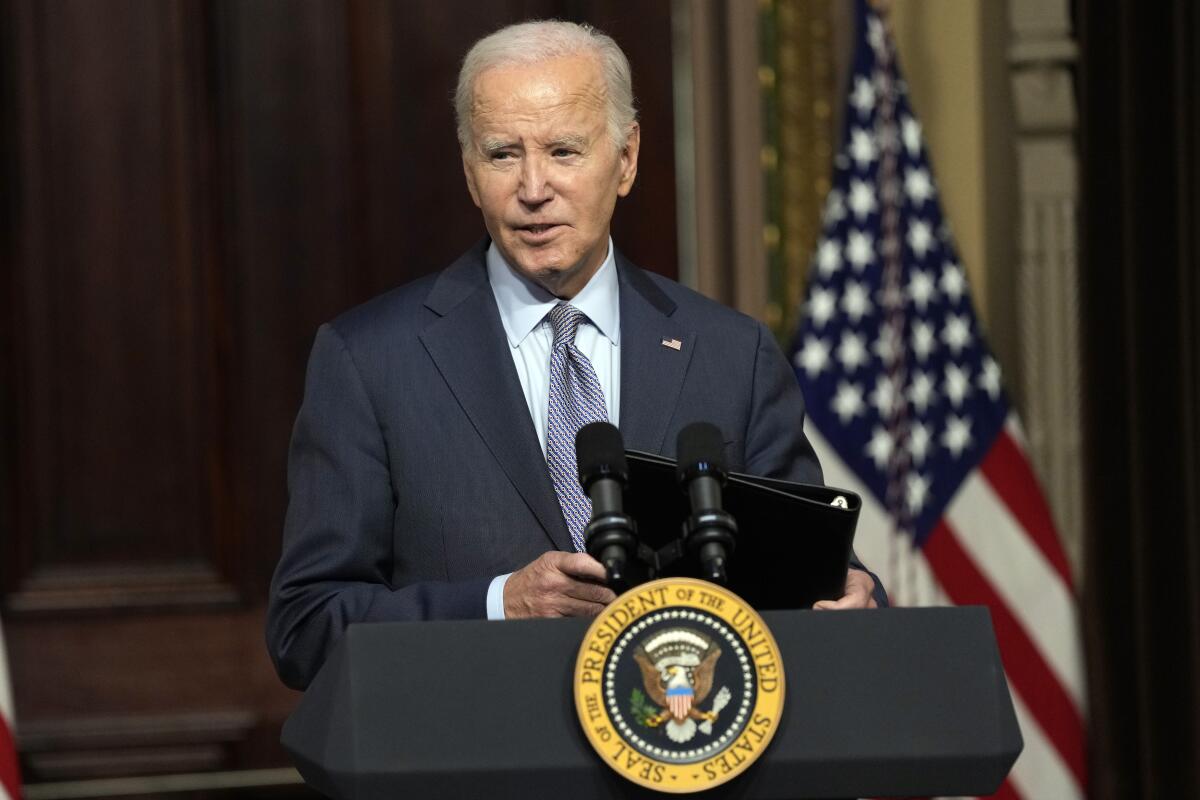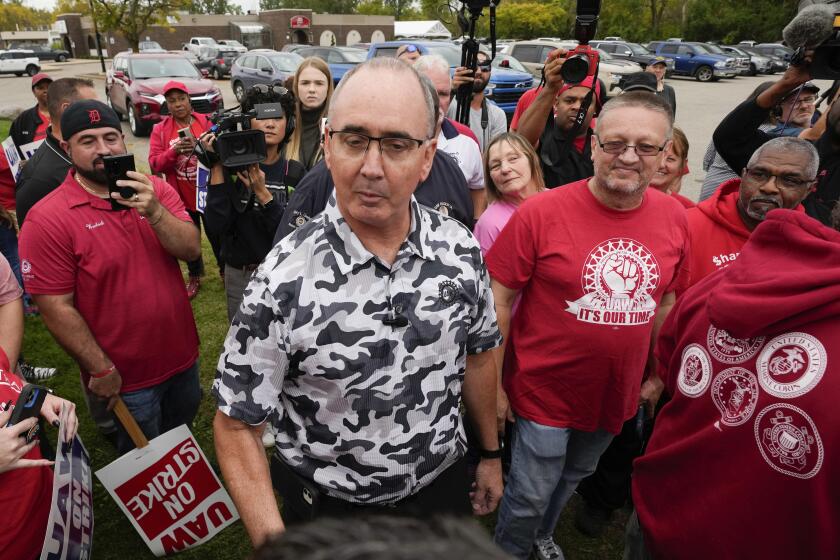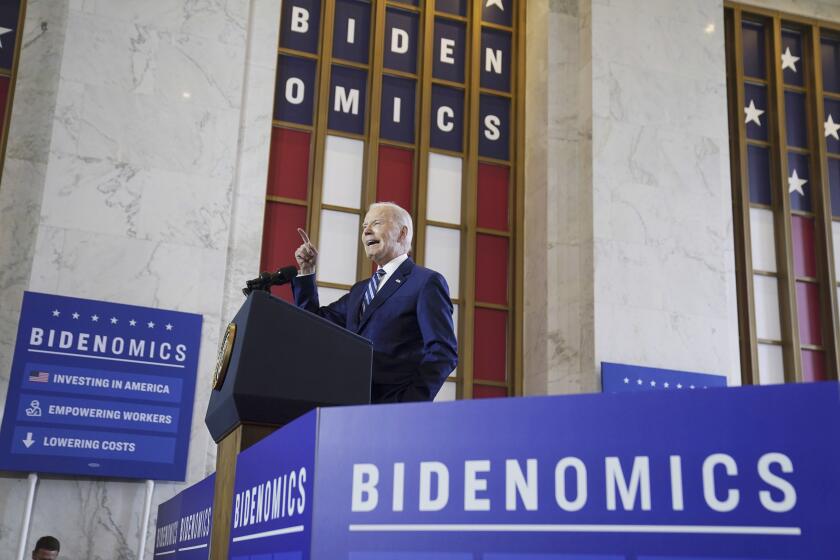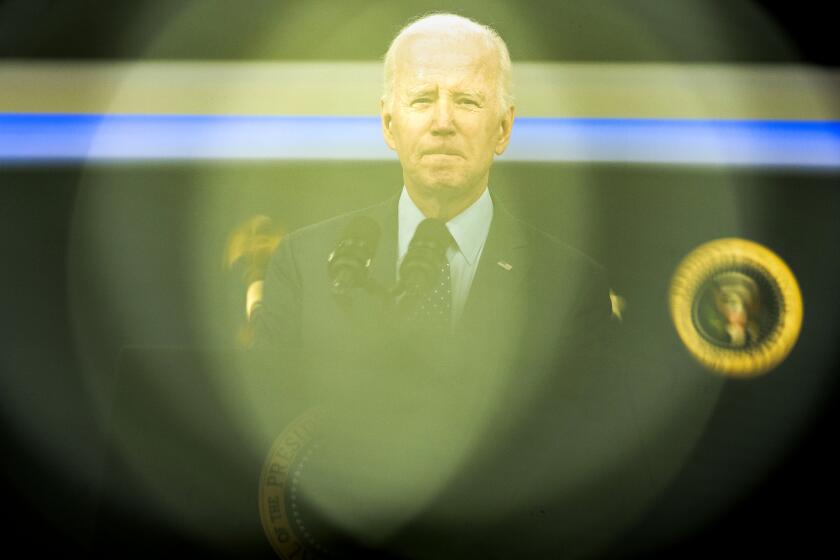The continuing riddle of why Biden doesn’t get credit for an improved economy

- Share via
Let’s take a snapshot of the U.S. economy.
Gross domestic product rose at an annualized rate of 4.9% in the third quarter of this year, which ended Sept. 30. That growth, which was fueled by unexpectedly robust consumer spending, surprised even the most experienced economists, not to mention pundits, who have been bracing for a slowdown.
Inflation has come down to an annual rate of 3.7%, a shadow of its peak in June 2022, when it reached 9.1%, then the highest rate in 40 years. Prices of energy, used cars and trucks, and medical care all fell in September from August.
Bidenomics didn’t just promise economic growth; it promised a transition from the era of trickle-down, neoliberal economics to a new paradigm that focused on improving the wages and livelihoods of working- and middle-class people.
— Roosevelt Institute
Gasoline prices, which for millions of Americans are the bellwether of inflation comparisons, averaged $3.418 a gallon nationwide Monday, according to the AAA, down by more than 7 cents in a week and by more than 32% since the average peaked at $5.03 in June 2022.
Gas prices are even lower in the heartland, just about $3 in Louisiana, South Carolina and Alabama and even lower in Texas, Georgia and Mississippi.
This at a moment when violence in the Middle East might have driven oil prices higher. Democrats might want to dust off those stickers showing President Biden pointing at pump prices and saying, “I did that,” which Republicans loved to post at gas stations during the summer of 2022, and repurpose them as advertisements for the decline of inflation.
Get the latest from Michael Hiltzik
Commentary on economics and more from a Pulitzer Prize winner.
You may occasionally receive promotional content from the Los Angeles Times.
Other economic indicators point to a fundamental shift in the character of government economic policy, so-called Bidenomics.
“Bidenomics didn’t just promise economic growth,” wrote economists at the progressive Roosevelt Institute in a recent newsletter; “it promised a transition from the era of trickle-down, neoliberal economics to a new paradigm that focused on improving the wages and livelihoods of working- and middle-class people.” They titled their post: “It’s working.”
Indeed, as I reported in July, lower-income workers have been the chief beneficiaries of Bidenomics. Economists David Autor of MIT and Arindrajit Dube and Annie McGrew of the University of Massachusetts determined in a paper published in March that lower-income workers had recovered about 25% of the increase in wage inequality that had built up over the previous four decades.
Organized labor seems to have experienced a renaissance, or at least the glimmer of one. Unions won more representation elections, 641, in the first half of 2022 than they had in the same period for 20 years. The victory by the United Auto Workers over the Big Three automakers after the recent strike may be a harbinger of more victories to come, but even if not, it’s certainly a high water mark for union activism over recent decades.
The UAW’s great new contracts with GM, Stellantis and Ford show that union solidarity and concrete goals bring major victories for workers for the first time in decades.
The Federal Reserve, in its triannual survey of household finances released last month, painted a bright picture: “Between 2019 and 2022, real median net worth surged 37%, and real mean net worth increased 23%,” the Fed reported. The increases in both categories were “near universal across different types of families, grouped by either economic or demographic characteristics.”
The rise in the median was the largest three-year increase since the Fed started paying attention, “more than double the next-largest one on record.” Household debt remained under control, with average credit card balances falling sharply.
Yet all this winning seems to have infused the American public with a sense of doom. Polls depict voters as walking around with a dark economic cloud over their heads and worse on the horizon.
“Voters are mad about the economy,” my colleague David Lauter reported last week from Washington. “All the polls say so.”
The discrepancy between what the numbers say and what voters purportedly believe has the White House stymied. Insiders blame the “Bidenomics” label, according to NBC News. Their concern is that it’s too nebulous to communicate the gains that the average family is experiencing (and that identifying the president with the economy could become a drag if the economy turns down before the 2024 election).
Hiltzik: Bidenomics has been a boon for working-class voters. Why don’t they give him credit?
Inflation is down sharply, employment is holding steady and GDP is growing. But Americans are still blaming Biden for a lousy recovery.
So what accounts for the discordance?
One factor is certainly the relentless doom-saying of Republicans and conservatives, amplified on social media and by the right-wing echo chamber. There isn’t a GOP officeholder or candidate who has ever referred to Biden’s economic policies as anything other than “disastrous.”
Sure, that’s politics. But that doesn’t mean that the news media are obligated to accept such assertions at face value. If any interviewer has ever asked a Republican to provide chapter and verse about what’s wrong with Bidenomics, I haven’t seen it.
That’s the case even though some claims by right-wingers are demonstrably false. Consider a recent tweet by Stephen Moore, a Heritage Foundation fellow with a regular platform on the Wall Street Journal op-ed page.
“Biden has created a government jobs boom. Good for Washington, bad for middle America,” Moore wrote, posting a chart that showed government job growth from January through September at 531,000 workers — far more than in most other private-sector employment categories.
As I’ve written in the past, taking Moore as some sort of economic truth-teller is a mug’s game. He’s an ideologue playing an economist on social media.
(He’s the co-author of a 2018 book titled “Trumponomics: Inside the America First Plan to Revive Our Economy,” which garnered a heartfelt paean from Trump, who called it “an incredible book on my economic policies.” Of course, “incredible” may not have meant what Trump thinks it meant.)

A few things about Moore’s tweet:
First, Moore put his thumb on the scale by combining all the new government jobs gained from January through September into one line, totaled as 531,000 new government jobs in that period. But he broke down all the private sector jobs into occupational categories, so that private sector job growth would look smaller.
Moreover, Moore’s figure is the sum of all government job gains, including state and local governments, which obviously Biden has nothing to do with. (State and local employees are typically public school teachers and college faculty.) For the federal government, which he heads, the increase over the first nine months of 2023 was 74,000, according to the Bureau of Labor Statistics.
Add up all the private sector figures, in any case, and they show that private-sector job increases were about 3.5 times higher than those in the federal government.
Moore’s assertion bears other signs of cherry-picking. Curiously, he covers only the last nine months. A reading of Biden’s entire tenure, starting at January 2021, gives the lie to Moore’s case: It shows that jobs in the private sector have grown at twice the pace of that in the federal government, and that federal jobs have actually declined as a percentage of total nonfarm employment, from about 1.6% in January 2021 to slightly less than 1.5% as of last month.
In other words, Bidenomics has created a private sector jobs boom. To recast Moore’s tweet, “Good for Washington, better for middle America.”
Worries about the advanced age of leading politicians are as old as Methuselah. But age isn’t related to whether a political leader is worthy or effective.
Opinion polls depicting Americans as almost universally discontented with the economy — and more to the point, pessimistic about its future course — are another factor. These poll results, reiterated endlessly on the air and on newspaper pages, tend to feed on themselves: If everyone else is down in the dumps, why should you feel any different?
But it’s wise to keep in mind something well known to polling experts: When you ask people what they expect from the future, they almost invariably say it will be just like today, except more so. If they think the economy has been declining, they’re not likely to foresee a turnaround ahead.
Still, that doesn’t explain why people think economic conditions are so dire today. One theory blames the residual effect of the yearlong bout of inflation the country suffered. Although it has faded, prices for many goods and services remain higher than they were. “People want to hear about falling prices, because they remember what prices were,” Jared Bernstein, Biden’s senior economic advisor, told NBC. “They want their old prices back.”
Others suggest that economists, pollsters and political commentators may actually be misreading the public’s mood — that people actually are feeling better about their own economic situation “but think the country is in terrible shape,” says Patrick Watson of Mauldin Economics, an analytics firm. “Maybe it’s because of the media always highlighting bad news.”
It’s also true that economic conditions always take time to penetrate public opinion — it’s not unusual for voters to continue to wring their hands about the economy for months after it starts delivering gains.
People may also be rattled by the unending warnings from economists and pundits about a recession lurking somewhere over the horizon. That could happen, but over recent months its predicted onset has receded further and further into the future.
Whatever ordinary people think, there is no question that Biden has made a U-turn in government economic policies that had been in place since the Reagan years — those supply-side initiatives that always promised to “trickle down” to the working class, but somehow never did.
The social democracy movement launched by Franklin Roosevelt’s New Deal “ran aground in the 1970s,” UC Berkeley economist Brad DeLong told me a year ago. It was supplanted by the neoliberal movement that favored the 1%. “The rich had the largest megaphones, and they trumpeted the fact that their incomes were growing rapidly. And those lower down ... were told that if only they were sufficiently worthy, the unleashed market would give to them too, and they more than half believed it.”
Biden has turned that back on its head. Voters may or may not believe it today, but most of them are benefiting from the change, and it’s just possible that they’ll eventually come around.
More to Read
Get the latest from Michael Hiltzik
Commentary on economics and more from a Pulitzer Prize winner.
You may occasionally receive promotional content from the Los Angeles Times.














